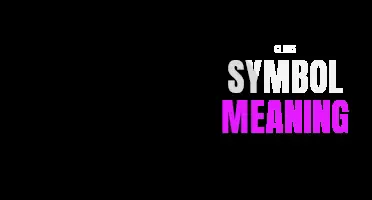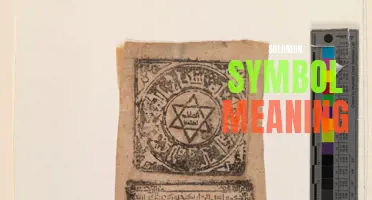
Spirit symbols have held a significant place in human culture for centuries. They serve as powerful visual representations of the intangible aspects of our existence, connecting us to the spiritual realm and embodying intricate meanings and messages. Whether expressed through iconic religious symbols, mystical traditions, or personal beliefs, these symbols offer a range of interpretations that transcend language barriers and cultural differences. As we dive into the exploration of spirit symbols and their meanings, we embark on a journey that invites us to unravel the depths of our own consciousness and unlock the secrets of the universe.
What You'll Learn
- What are some common spirit symbols and their meanings?
- How do different cultures interpret spirit symbols?
- Are spirit symbols universal or do they vary across different spiritual traditions?
- Can spirit symbols be personalized or do they have fixed meanings?
- How can understanding spirit symbols and their meanings enhance one's spiritual practice?

What are some common spirit symbols and their meanings?
Spirit symbols are powerful tools that can provide guidance and insight into our spiritual journey. These symbols come in various forms, including animals, plants, objects, and celestial bodies. Each symbol carries its own unique meaning and can represent different aspects of the spiritual realm. Here are some commonly recognized spirit symbols and their meanings:
- Butterfly: The butterfly is a symbol of transformation and change. It represents the process of personal growth and the journey towards self-discovery. Seeing a butterfly may indicate that a significant change is about to occur in your life.
- Wolf: The wolf is a symbol of strength, loyalty, and intuition. It represents the ability to trust your instincts and navigate through challenging situations. The wolf is often associated with protection and guidance from unseen forces.
- Lotus Flower: The lotus flower is a symbol of spiritual awakening and enlightenment. It represents purity and the ability to rise above challenging circumstances. The lotus flower grows in muddy waters but remains untouched by the impurities around it, symbolizing inner strength and resilience.
- Feather: Feathers are often seen as signs from the spirit world. Finding a feather may indicate that your loved ones in spirit are sending you a message or offering their guidance and support. Feathers are generally associated with freedom, lightness, and the ability to transcend limitations.
- Moon: The moon symbolizes the divine feminine, intuition, and emotions. It represents cycles, renewal, and the ebb and flow of life. The different phases of the moon are often associated with different energies and can provide insights into our own emotions and spiritual growth.
- Cross: The cross is a symbol of faith, protection, and divine love. It represents the connection between the physical and spiritual realms and serves as a reminder to stay connected to one's beliefs and values. The cross can also symbolize sacrifice and resurrection.
- Owl: The owl is a symbol of wisdom, intuition, and the ability to see beyond surface appearances. It represents the ability to see the truth and navigate through the darkness. Owls are often associated with spiritual guidance and the uncovering of hidden knowledge.
- Sun: The sun is a symbol of vitality, power, and enlightenment. It represents the source of life and the energy that fuels all living beings. The sun symbolizes warmth, growth, and the ability to illuminate our path and provide clarity in times of darkness.
- Tree: The tree is a symbol of grounding, strength, and connection to the Earth. It represents stability, growth, and the ability to adapt to changing circumstances. Trees are often associated with wisdom and the interconnectedness of all living beings.
- Infinity Symbol: The infinity symbol represents eternity, infinite love, and limitless possibilities. It symbolizes the interconnectedness of all things and the continuous cycle of life and death. The infinity symbol reminds us that there is no end to our spiritual journey and that we are always evolving.
These are just a few examples of commonly recognized spirit symbols and their meanings. It's important to remember that the interpretation of these symbols can vary depending on personal beliefs and cultural references. When encountering a spirit symbol, take a moment to reflect on its meaning and the message it may hold for you in your spiritual journey.
The Hidden Meanings Behind the Double Triangle Symbol
You may want to see also

How do different cultures interpret spirit symbols?
Spirit symbols have been used by different cultures throughout history as a way to communicate and connect with the spiritual world. These symbols hold significant meaning and are often interpreted differently across various cultures. In this article, we will explore how different cultures interpret spirit symbols.
Firstly, let's start with Native American culture. Native Americans believe that everything in nature has a spirit, and they use symbols to represent these spirits. One well-known symbol is the dreamcatcher, which is believed to filter out bad dreams and allow good dreams to pass through. The dreamcatcher symbolizes protection and spiritual guidance for Native Americans.
Moving on to Hinduism, another culture known for its rich symbolism. In Hinduism, the Om symbol is highly revered. It is believed to be the sound of the creation of the universe and represents the ultimate reality. The Om symbol is often chanted during meditation and is seen as a pathway to spiritual enlightenment.
In Chinese culture, the Yin and Yang symbol is widely recognized. This symbol represents the balance between opposing forces such as light and dark, male and female, and positive and negative. The Yin and Yang symbol is a reminder of the harmony that exists in the universe and the need for balance in all aspects of life.
Ancient Celtic culture also had its own interpretation of spirit symbols. The Celtic knot, for example, is a symbol of eternal love and the interconnectedness of all things. It is often depicted as an intricate design with no starting or ending point, symbolizing the infinite nature of the spiritual world.
In Egyptian culture, the Ankh symbol is prominent. The Ankh represents eternal life and is often associated with the god of the afterlife, Osiris. It is also seen as a symbol of fertility and new beginnings, connecting the spiritual and physical realms.
Lastly, let's explore the interpretation of spirit symbols in Maori culture, an indigenous culture of New Zealand. The koru symbol, which resembles an unfurling fern frond, represents new life, growth, and rejuvenation. It is often associated with the cycle of life and the interconnectedness of all things in nature.
In conclusion, different cultures interpret spirit symbols in unique ways, reflecting their beliefs and spiritual practices. From Native American dreamcatchers to Hindu Om symbols, Chinese Yin and Yang, Celtic knots, Egyptian Ankh, and Maori koru, these symbols hold deep meaning and serve as a powerful tool for connecting with the spiritual world. Understanding the diverse interpretations of spirit symbols can deepen our appreciation for the rich tapestry of human spirituality.
Exploring the Symbolic Meaning Behind the Carhartt Logo
You may want to see also

Are spirit symbols universal or do they vary across different spiritual traditions?
Symbols have always played a significant role in human culture and spirituality. They allow us to express complex ideas, emotions, and concepts in a visual or symbolic form. In many spiritual traditions, symbols hold deep meaning and are believed to have the power to convey messages and connect individuals to the spiritual realm. But the question remains, are spirit symbols universal or do they vary across different spiritual traditions?
The answer to this question is not straightforward. While there are certain symbols that can be found across different spiritual traditions, such as the lotus flower, the cross, or the yin and yang, many symbols are specific to a particular spiritual tradition or culture. This is because symbols are often a reflection of a community's unique beliefs, values, and experiences.
In some cases, symbols may have similar meanings but different visual representations. For example, the concept of the sun is often associated with energy, life, and vitality. However, the symbol for the sun can vary across different cultures. In ancient Egypt, the sun was represented by the Eye of Horus, while in Aztec culture, the sun was represented by a circular symbol with rays emanating outwards. Despite the visual differences, both symbols convey the idea of the sun's power and importance.
Similarly, spiritual symbols can vary in their cultural associations. The lotus flower, for instance, is a widely recognized symbol of purity and enlightenment in Buddhism. In Hinduism, it is also associated with beauty and fertility. While the core concept of the lotus may be similar, its symbolic meaning can change depending on the cultural context.
Another factor that contributes to the variation of spirit symbols is the individual interpretation of the symbol. Symbols are open to interpretation, and individuals may attach personal meaning and significance to a particular symbol based on their own beliefs and experiences. This personalized interpretation can further contribute to the diversity of spirit symbols within a single tradition.
Despite the variations, there are certain archetypal symbols that can be found in many spiritual traditions. These symbols are often associated with universal concepts and experiences. For example, the symbol of a tree can be found in various spiritual traditions, representing growth, wisdom, and the connection between heaven and earth. The image of a snake shedding its skin is also a common symbol found in many cultures, representing rebirth and transformation.
In conclusion, while there are certain symbols that can be found across different spiritual traditions, the majority of spirit symbols are specific to a particular tradition or culture. Symbols are deeply rooted in a community's beliefs, values, and experiences, making them unique to that specific context. However, there are also archetypal symbols that can be found across different traditions, representing universal concepts and experiences. Overall, spirit symbols are a rich and diverse aspect of human spirituality, reflecting the complexity and depth of our collective beliefs.
Understanding the Symbols in Dead by Daylight: A Guide to their Meanings
You may want to see also

Can spirit symbols be personalized or do they have fixed meanings?
Spirit symbols can be found in various cultures and religions around the world. These symbols are often associated with specific meanings and are used to represent deep spiritual concepts. While there are common interpretations for many spirit symbols, they can also be personalized and have different meanings for different individuals.
When it comes to spirit symbols, there are numerous examples to choose from. The lotus flower, for instance, is a symbol of purity and enlightenment in many Asian religions, including Buddhism and Hinduism. The tree of life is another widely recognized symbol that represents the interconnectedness of all living things. These symbols have been used for centuries and have consistent meanings across different cultures and traditions.
However, it is essential to note that symbols can also carry personal significance and meaning. A symbol may hold different meanings for different individuals based on their experiences, beliefs, and cultural backgrounds. For example, while the lotus flower is generally associated with purity and enlightenment, it could also be seen as a symbol of resilience and growth for someone who has overcome challenging circumstances in their life.
Personalization of spirit symbols can occur on an individual level or within specific spiritual practices. People might develop a personal connection with a particular symbol through meditation, dreams, or other spiritual experiences. Additionally, some spiritual traditions have practices that allow individuals to infuse symbols with their unique energy and intentions.
In certain belief systems, individuals may create their symbols or modify existing ones to reflect their personal spiritual journey. This customization can involve adding or altering elements of a symbol to enhance its personal meaning. For example, someone may incorporate specific colors, patterns, or other symbols into a traditional symbol to represent their unique experiences and beliefs.
It is crucial to approach personalized spirit symbols with respect and an understanding of their cultural and historical significance. While personalization is a valid expression of spirituality, it is essential not to appropriate or disrespect the symbols and their traditional meanings.
In conclusion, spirit symbols often have fixed meanings across different cultures and religions. However, they can also be personalized and hold different meanings for different individuals. Personalization of spirit symbols can occur through personal experiences, beliefs, cultural backgrounds, and specific spiritual practices. It is important to approach personalized symbols with respect and an understanding of their traditional and cultural significance.
Understanding the Car with Key Symbol: What Does It Mean?
You may want to see also

How can understanding spirit symbols and their meanings enhance one's spiritual practice?
Spirit symbols are powerful tools that hold deep meanings in various spiritual practices. These symbols can be found in different cultures and religions throughout history, and understanding their meanings can greatly enhance one's spiritual practice. By delving into the significance of these symbols, individuals can deepen their spiritual connection, gain insight into their own inner selves, and find guidance on their spiritual journey.
First and foremost, spirit symbols act as visual representations of abstract concepts and ideas. These symbols carry profound meanings that go beyond words, allowing individuals to tap into the collective unconscious and communicate with the spiritual realm. When one studies and understands these symbols, they are able to access deeper levels of consciousness, leading to heightened spiritual awareness and a stronger connection with the divine.
Symbols have the power to communicate with the subconscious mind, which plays a crucial role in spiritual practices. By integrating these symbols into meditation or mindfulness exercises, practitioners can create a focus point to quiet the mind and enter a state of deep relaxation. For example, a person may choose to meditate on the symbol of the lotus flower, a common symbol of enlightenment and spiritual growth in various cultures. By visualizing the lotus flower during meditation, individuals can align themselves with its qualities, such as purity and the unfolding of the soul.
Moreover, spirit symbols can offer profound insights into one's own inner self and spiritual journey. Each symbol carries its own unique meaning, and by exploring these meanings, individuals can gain a deeper understanding of their own beliefs, values, and experiences. For example, the symbol of the tree of life is found in many spiritual traditions and represents the interconnectedness of all living beings. By contemplating this symbol, individuals may reflect on their own connections with others and their place in the larger cosmic order.
Spirit symbols can also serve as guides on one's spiritual path. They offer wisdom and guidance, acting as reminders of important values and principles. For instance, the symbol of the labyrinth often represents a journey of self-discovery and spiritual growth. By engaging with this symbol, individuals can seek guidance on their own personal journeys, navigating through the challenges and finding the path that leads to their true selves.
Finally, spirit symbols can foster a sense of unity and connection with others who share similar spiritual practices. These symbols are often recognized and understood by individuals who walk a similar spiritual path, creating a sense of community and shared experiences. By understanding and using these symbols, individuals can connect with others in a meaningful way and find support and encouragement along their spiritual journey.
In conclusion, understanding spirit symbols and their meanings can greatly enhance one's spiritual practice. These symbols serve as visual representations of abstract concepts and ideas, allowing individuals to tap into the collective unconscious and communicate with the spiritual realm. By integrating these symbols into meditation and mindfulness exercises, individuals can deepen their spiritual connection and access deeper levels of consciousness. Spirit symbols also offer insights into one's inner self and serve as guides on the spiritual path. Additionally, these symbols foster a sense of community and connection with others who share similar beliefs and practices. Embracing the power of spirit symbols can truly enhance and enrich one's spiritual journey.
Decoding the Symbolic Meaning Behind the Ecuador Flag
You may want to see also
Frequently asked questions
The lotus flower is highly regarded as a spiritual symbol in many cultures. Its ability to grow and thrive in muddy waters, while still producing a beautiful and pristine flower, is seen as a metaphor for spiritual growth and enlightenment. It represents purity, rebirth, and the journey towards awakening and self-realization.
The infinity symbol, with its sleek and continuous loop, is often associated with eternity and limitless possibilities. In spirituality, it represents the interconnectedness of all things and the infinite nature of existence. It serves as a reminder that we are part of something larger than ourselves and that our souls are eternal.
The Tree of Life is a symbolic representation found in various spiritual and religious traditions. It is often seen as a metaphor for the interconnectedness of all living beings and the cycle of life, death, and rebirth. The roots of the tree represent our connection to the earth, the branches symbolize our aspirations and growth, and the leaves signify the abundance and vitality of life.
The dove is often seen as a symbol of peace, purity, and divine guidance in many spiritual traditions. In Christianity, it represents the Holy Spirit and is associated with hope and the presence of God. In other cultures, the dove is believed to bring messages from the divine and serves as a reminder of the importance of harmony and love.
The spiral is a powerful and ancient symbol that has been used in various spiritual traditions. It represents the journey of life, growth, and transformation. The spiral shape can be found in natural phenomena such as seashells, galaxies, and plants, which further emphasizes its connection to the cycles of nature and the universe. In spirituality, the spiral symbolizes our continuous evolution and the expansion of consciousness.







